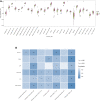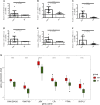Identification of Diagnostic Markers Correlated With HIV+ Immune Non-response Based on Bioinformatics Analysis
- PMID: 35004856
- PMCID: PMC8727996
- DOI: 10.3389/fmolb.2021.809085
Identification of Diagnostic Markers Correlated With HIV+ Immune Non-response Based on Bioinformatics Analysis
Abstract
Background: HIV-infected immunological non-responders (INRs) are characterized by their inability to reconstitute CD4+ T cell pools after antiretroviral therapy. The risk of non-AIDS-related diseases in INRs is increased, and the outcome and prognosis of INRs are inferior to that of immunological responders (IRs). However, few markers can be used to define INRs precisely. In this study, we aim to identify further potential diagnostic markers associated with INRs through bioinformatic analyses of public datasets. Methods: This study retrieved the microarray data sets of GSE106792 and GSE77939 from the Gene Expression Omnibus (GEO) database. After merging two microarray data and adjusting the batch effect, differentially expressed genes (DEGs) were identified. Gene Ontology (GO) resource and Kyoto Encyclopedia of Genes and Genomes (KEGG) resource were conducted to analyze the biological process and functional enrichment. We performed receiver operating characteristic (ROC) curves to filtrate potential diagnostic markers for INRs. Gene Set Enrichment Analysis (GSEA) was conducted to perform the pathway enrichment analysis of individual genes. Single sample GSEA (ssGSEA) was performed to assess scores of immune cells within INRs and IRs. The correlations between the diagnostic markers and differential immune cells were examined by conducting Spearman's rank correlation analysis. Subsequently, miRNA-mRNA-TF interaction networks in accordance with the potential diagnostic markers were built with Cytoscape. We finally verified the mRNA expression of the diagnostic markers in clinical samples of INRs and IRs by performing RT-qPCR. Results: We identified 52 DEGs in the samples of peripheral blood mononuclear cells (PBMC) between INRs and IRs. A few inflammatory and immune-related pathways, including chronic inflammatory response, T cell receptor signaling pathway, were enriched. FAM120AOS, LTA, FAM179B, JUN, PTMA, and SH3YL1 were considered as potential diagnostic markers. ssGSEA results showed that the IRs had significantly higher enrichment scores of seven immune cells compared with IRs. The miRNA-mRNA-TF network was constructed with 97 miRNAs, 6 diagnostic markers, and 26 TFs, which implied a possible regulatory relationship. Conclusion: The six potential crucial genes, FAM120AOS, LTA, FAM179B, JUN, PTMA, and SH3YL1, may be associated with clinical diagnosis in INRs. Our study provided new insights into diagnostic and therapeutic targets.
Keywords: INRs; IRs; bioinformatic gene analysis; diagnostic markers; gene expression omnibus.
Copyright © 2021 Bai, Li, Hou, Lv, Wang, Hua, Wu and Dai.
Conflict of interest statement
The authors declare that the research was conducted in the absence of any commercial or financial relationships that could be construed as a potential conflict of interest.
Figures







Similar articles
-
Identification of Potential Diagnostic Genes of HIV-Infected Immunological Non-Responders on Bioinformatics Analysis.J Inflamm Res. 2023 Apr 14;16:1555-1570. doi: 10.2147/JIR.S396055. eCollection 2023. J Inflamm Res. 2023. PMID: 37082297 Free PMC article.
-
Identification of potential crucial genes in atrial fibrillation: a bioinformatic analysis.BMC Med Genomics. 2020 Jul 18;13(1):104. doi: 10.1186/s12920-020-00754-5. BMC Med Genomics. 2020. PMID: 32682418 Free PMC article.
-
Elucidating the Gene Signatures and Immune Cell Types in HIV-Infected Immunological Non-Responders by Bioinformatics Analyses.Int J Gen Med. 2022 Dec 7;15:8491-8507. doi: 10.2147/IJGM.S390642. eCollection 2022. Int J Gen Med. 2022. PMID: 36514742 Free PMC article.
-
Ferroptosis and Dysfunction of CD3+CD4-CD8- T Cells are Associated with Poor Immune Reconstitution in HIV Patients.Curr HIV Res. 2025 May 20. doi: 10.2174/011570162X366300250509112302. Online ahead of print. Curr HIV Res. 2025. PMID: 40396294
-
Comparative Transcriptional Analysis Identified Characteristic Genes and Patterns in HIV-Infected Immunological Non-Responders.Front Immunol. 2022 Jan 28;13:807890. doi: 10.3389/fimmu.2022.807890. eCollection 2022. Front Immunol. 2022. PMID: 35154126 Free PMC article.
Cited by
-
TTC7B Is a Novel Prognostic-Related Biomarker in Glioma Correlating with Immune Infiltrates and Response to Oxidative Stress by Temozolomide.Oxid Med Cell Longev. 2022 Sep 20;2022:7595230. doi: 10.1155/2022/7595230. eCollection 2022. Oxid Med Cell Longev. 2022. Retraction in: Oxid Med Cell Longev. 2023 Sep 27;2023:9787264. doi: 10.1155/2023/9787264. PMID: 36193074 Free PMC article. Retracted.
-
Identification of Potential Diagnostic Genes of HIV-Infected Immunological Non-Responders on Bioinformatics Analysis.J Inflamm Res. 2023 Apr 14;16:1555-1570. doi: 10.2147/JIR.S396055. eCollection 2023. J Inflamm Res. 2023. PMID: 37082297 Free PMC article.
-
Prognostic value of RRM1 and its effect on chemoresistance in pancreatic cancer.Cancer Chemother Pharmacol. 2024 Mar;93(3):237-251. doi: 10.1007/s00280-023-04616-6. Epub 2023 Dec 1. Cancer Chemother Pharmacol. 2024. PMID: 38040978
-
FDCSP Is an Immune-Associated Prognostic Biomarker in HPV-Positive Head and Neck Squamous Carcinoma.Biomolecules. 2022 Oct 12;12(10):1458. doi: 10.3390/biom12101458. Biomolecules. 2022. PMID: 36291667 Free PMC article.
-
SH3YL1 Protein Predicts Renal Outcomes in Patients with Type 2 Diabetes.Life (Basel). 2023 Apr 7;13(4):963. doi: 10.3390/life13040963. Life (Basel). 2023. PMID: 37109492 Free PMC article.
References
-
- Baker J. V., Peng G., Rapkin J., Krason D., Reilly C., Cavert W. P., et al. (2008b). Poor Initial CD4+ Recovery with Antiretroviral Therapy Prolongs Immune Depletion and Increases Risk for AIDS and Non-AIDS Diseases. J. Acquir. Immune. Defic. Syndr. 48, 541–546. 10.1097/QAI.0b013e31817bebb3 - DOI - PMC - PubMed
LinkOut - more resources
Full Text Sources
Research Materials
Miscellaneous

